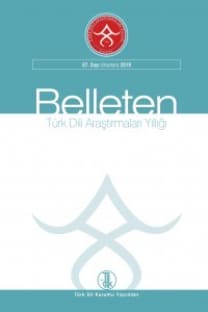KIRGIZLARDA KOYUN KEMİKLERİNİN İSİMLENDİRİLMESİ, BUNLARIN MİSAFİR AĞIRLAMA SIRASINDAKI DAĞITIMI VE KEMİK İSİMLERİNE ETİMOLOJİK BİR YAKLAŞIM
Hayvancılık geleneği asırlar boyu Kırgızlarda önemli bir yer tutmaktadır. Hayvancılık Kırgızlar için hem bir geçim kaynağı hem de kültürün bir parçası olmuştur. Kırgızistan’da hayvancılık geleneğinin devam ettirilmesiyle birlikte misafir ağırlama geleneğinde genellikle büyük veya küçük baş hayvan kesilmesi önemli yer tutmaktadır.Bu makalede, Kırgız Türkçesindeki koyun kemik isimleri, misafir ağırlama sırasındaki dağıtımı ve kemik isimleri etimolojik yönden incelenecektir. Bununla birlikte Kırgız Türkçesinin Batken şivesi, öbür Türk dilleriyle karşılaştırılacaktır
Anahtar Kelimeler:
Koyun kemik isimleri, Batken ağzı, Kazak Türkçesi, Moğalca
Demonination of Sheep-Bones in Kyrgyz, How These is Served to the Honor Guests and an Etymological Approachment to the Names of Sheep-Bones
centuries. Livestock husbandary is one of traditional foundations of the economy and culture of the Kyrgyz people. In addition to livestock husbandary, the traditional hospitality of the Kyrgyz people has also taken an important place in the national culture, especially slaughtering sheep and the serving of meat according to the age and honor of the guests. This article will present the names of sheep-bones, and duscuss how meat is served according to the age and honor guests. It will also offer etymological explanations of the names of sheep-bones. The names of the sheep-bones with Standard-Kyrgyz Language and Batken Dialect Kyrgyz will be compared with other modern Tükic Languages.
Keywords:
Names of sheep-bones, Batken dialect, Kazak language, Mongolian language,
- ISSN: 0564-5050
- Başlangıç: 1953
- Yayıncı: Türk Dil Kurumu
